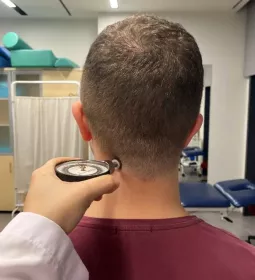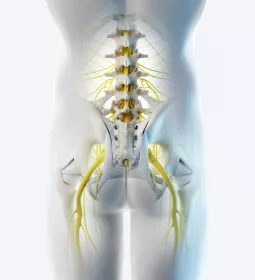Few medical practitioners work with dancers and even fewer truly understand dance biomechanics, making dancers an underserved community. In an interview in December 2023, Kathleen Davenport said 98 percent of all dance injuries do not require surgical intervention.
Dancers are an ever-growing population that use massage and massage therapists as their primary medical practitioner for musculoskeletal injuries and to keep them in peak condition. Understanding the biomechanics of your client’s particular dance style will give you better results. Understanding that dancers are always “in season” helps you better work with their biopsychosocial issues.
Massage for Peak Performance and Mental Health
A dancer’s identity is deeply intertwined with their ability to dance. Their life revolves around rehearsals, performances, and dance classes. When injured, their world is disrupted, not only physically but also psychologically and socially. Unable to engage in their passion, dancers may experience feelings of depression, discouragement, and social withdrawal, driven by the urgency to return to dance prematurely, risking further injury.
Massage therapy offers both physical and mental benefits for dancers. Physically, it improves circulation, reduces muscle stiffness and joint inflammation, aids recovery, enhances flexibility, and alleviates pain and soreness. These benefits are valuable for both injured and uninjured dancers. However, for the injured dancer, the mental benefits are especially crucial. Massage reduces stress, lifts mood, eases anxiety, and promotes an overall sense of well-being. These psychological benefits empower dancers to actively participate in their injury rehabilitation, creating an optimal environment for both mental and physical healing. While massage cannot accelerate the healing process, it plays a vital role in supporting dancers through their recovery journey.
A Retrospective Study
Dance demands athleticism, combining rigorous physical activity with artistic expression. It involves intricate movements that require flexibility, strength, stability, and balance while adhering to choreography. However, dancers often lack access to proper health-care resources such as athletic trainers and physical therapy, despite injury rates comparable to or higher than those in sports like football.¹

In a retrospective study of an Australian ballet company from January 2018–December 2021, 73 professional dancers (40 women and 33 men) had the following reported musculoskeletal injury rates: 953 medical-attention injuries were recorded in 72 dancers (98 percent) at an injury rate of 2.79 per 1,000 hours of dance. Of those injuries, 706 were time-loss injuries, which were reported in 70 dancers at an injury rate of 2.07 per 1,000 hours. Overuse injuries represented 53 percent of medical-attention injuries. The study concluded that almost all dancers required medical-attention for at least one injury during the surveillance period. Approximately 74 percent of injuries resulted in time lost dancing.²
Rachel List, director of the Dance Department at Hofstra University, notes that many professional dancers lack on-site health care and health insurance, highlighting the need for comprehensive support. Emphasizing physical injuries alone overlooks the emotional, financial, and social strains on dancers.
The psychological benefits of massage empower dancers to actively participate in their injury rehabilitation, creating an optimal environment for both mental and physical healing.
Massage therapy plays a crucial role in addressing musculoskeletal issues and supporting dancers’ overall well-being. Massage therapists like Robert Van Buren, who is based in New York City and works with pre-professional and professional dancers, emphasize the role of massage in affecting the nervous system and understanding dancers’ movements.
Overview of Dance-Related Injuries
Injuries in dance commonly stem from two sources: acute incidents due to faulty technique and chronic overuse. Acute injuries, such as fractures and ligament injuries, result from sudden trauma, while chronic injuries, like tendinitis and stress fractures, arise from long-term repetitive movements and muscular imbalances. Amy Marshall, an adjunct dance professor and artistic director, emphasizes that many chronic injuries stem from muscular imbalances, making massage therapy essential for addressing them. Dance careers can be shortened by injury, with different dance styles leading to distinct injury patterns.

Ankle injuries in dancers encompass a range of conditions, including sprains, impingement syndromes, tendinopathies, and stress fractures. Foot injuries are equally diverse, involving issues like stress fractures, bunions, and plantar fasciitis. Risk factors for dance-related injuries can be categorized as extrinsic or intrinsic. Extrinsic factors include the style of dance, rehearsal duration, floor type, and environmental conditions, while intrinsic factors involve individual attributes like age, gender, injury history, and joint flexibility.
Classical ballet technique emphasizes turnout, which places significant demands on the lower extremities. Limitations in hip rotation can lead dancers to compensate by externally rotating the tibia and pronating the ankle, increasing stress on the medial ankle, tibia, and knee. Addressing pain or dysfunction in ballet positions necessitates attention to the entire lower extremity, including the intrinsic foot muscles. In an interview in December 2023, Kathleen Davenport, physiatrist at Hospital for Special Surgery Florida–West Palm Beach, president of the International Association for Dance Medicine and Science, and former professional dancer, stressed the importance of massage in preventing and rehabilitating dance injuries, especially for elite dancers.
Common Dance Injuries and Massage Application
It’s estimated that 90 percent of dancers will experience injury at least once in their lifetime,³ and the majority of those occur in the lower extremities. Here are a few of those foot and ankle injuries and how massage can help.
Ankle Sprains
Ankle sprains are the most common ankle injury among dancers, often caused by improper landing during jumps or slipping when the foot is plantar flexed as in relevé. Early and aggressive treatment is crucial, including ice massage, compression taping, and, in severe cases, the use of a removable boot for up to three weeks. Massage focuses on working the lateral ankle ligaments, foot, and calf, including the peroneal muscles. Rehabilitation focuses on restoring ankle stability and mobility, with exercises targeting proprioception, peroneal strengthening, and full range of motion in subtalar and ankle joints. The goal is to regain stability, particularly for dancing en pointe.
Achilles Tendinopathy
Achilles tendinopathy encompasses acute and chronic tendinosis, typically manifesting with localized pain near the calcaneal insertion. Dancers often experience dull aches or discomfort, along with nodules and crepitus upon foot movement. Overtraining, especially in relevé and with jumps, commonly causes Achilles tendon injuries, with acute ruptures typically requiring surgical repair. Excessive pronation due to forced turnout heightens the risk of Achilles tendon problems.

Conservative treatment, including orthotics and physical modalities for pain relief, is often preferred, along with nonsteroidal anti-inflammatory drugs (NSAIDs) in the acute phase. Emphasis should be on correcting training errors and addressing contributing factors, with rehabilitation focusing on muscle-tendon imbalances and stretching/strengthening exercises. Massage should focus on the calf muscles and muscles of the foot and knee.
Impingement Syndromes
Ankle posterior impingement syndrome occurs when dancing en pointe, in maximal plantar flexion, and en demi pointe, causing pain and tenderness at the back of the ankle. Differential diagnosis includes os trigonum syndrome, flexor hallucis longus tendinitis, and Achilles tendinitis, discernible through the plantar flexion test. Nonsurgical management involves technique retraining, joint mobilization, ice, and NSAIDs, along with limiting plantar flexion and pointe work and correcting malalignments. Massaging the plantar aspect of the foot (especially the Achilles tendon insertion), the calf, and the knee is very valuable.

Anterior ankle impingement syndrome results from repetitive dorsiflexion or rapid plantar flexion, causing compression between the talus and tibia. Symptoms include restricted pliés, pain with deep pliés, swelling at the anterior ankle joint, and osteophytes. Initial conservative treatment includes activity modifications, restriction of pointe work, and implementation of barre exercises for support during the acute phase. Addressing the tibialis anterior—especially the tendon and posterior and gastrocsoleus complex—during massage work is beneficial.
Flexor hallucis longus (FHL) tenosynovitis, known as dancer’s tendinitis, correlates with posterior ankle impingement. Dancers may experience pain, swelling, or toe triggering. Management includes technique adjustments, avoiding specific dance movements, ice therapy, and NSAIDs. Stretching exercises that optimize FHL movement and relieve symptoms are beneficial.
Shin Splints
Shin splints, an overuse injury affecting the lower leg, stem from excessive strain on the posterior and anterior tibialis tendons, often causing pain along the inner and outer edges of the tibia, respectively. Rest, modified activity, and targeted stretching routines typically alleviate symptoms. Recovery may involve low-impact aerobic exercises like swimming or cycling, pain-relieving medications, ice therapy, compression bandages, and muscle-strengthening exercises for the lower leg and hip. Massaging the anterolateral and posteromedial aspects of the lower leg along with gentle stretching is very effective, as is working the hip.
Cuboid Subluxation
Cuboid subluxation can result from ankle sprains or repetitive plantar/dorsiflexion movements en pointe. It affects peroneal tendon function and should be considered in peroneal tendinitis cases. Clinical examination techniques like the cuboid whip and squeeze help realign the cuboid, though caution is needed in patients with concurrent lateral ankle sprains.
Note: The following techniques should not be performed on clients with suspected fractures, recent acute injuries, or systemic conditions affecting bone integrity.
The cuboid whip is both an assessment and potential corrective technique used to evaluate the mobility of the cuboid. When performed properly, it may help reposition a subluxed cuboid and provide immediate relief.

To perform the technique, have the client lie prone with the knee bent to 90 degrees and the foot relaxed. Support the front of the foot while placing your thumbs over the plantar surface of the cuboid. With the foot gently plantar flexed and inverted, the therapist delivers a quick, controlled thrust into plantar flexion and eversion, simultaneously applying upward pressure to the cuboid. A “click” or shift may be felt if the cuboid was previously restricted, and clients may report a reduction in pain or improved comfort when standing or walking.
The cuboid squeeze is a simple, noninvasive assessment used to provoke symptoms and evaluate the integrity of the cuboid region. It can help determine if further evaluation or referral may be warranted.

To perform, have the client sit or lie supine with the foot supported. Use both hands to apply medial-to-lateral compression directly over the cuboid bone. A positive test occurs when the client reports pain or discomfort, suggesting inflammation, mechanical irritation, or possible cuboid involvement in their symptoms.
Lisfranc Joint Injuries
Dancers often experience midfoot sprains and Lisfranc joint injuries, affecting the stability of the midfoot and metatarsal arches. These injuries typically result from loss of balance en pointe, during spins, or when landing jumps, leading to hyperplantar flexion injuries. Surgical intervention is often necessary, followed by a nonweight-bearing period in a walking boot during rehabilitation. Gentle pain-free massage of the metatarsals and intrinsic muscles can help alleviate symptoms and pain. Gait mechanics will also be affected and addressing those muscles is beneficial.
Fractures
Another common injury associated with ankle sprains is a dancer’s fracture, a spiral fracture of the fifth metatarsal neck. It occurs when rolling off pointe or landing on the lateral aspect of the foot after a jump. Treatment varies based on the fracture zone. Avulsion fractures in zone 1 can often be managed conservatively with protected weight bearing, while Jones fractures in zone 2 may require nonweight bearing in a short leg cast due to a propensity for nonunion. Diaphyseal zone 3 stress fractures pose more challenges, potentially requiring extended immobilization and having a higher risk of nonunion development. Massaging the metatarsals can be contraindicated until the fracture has healed and the doctor has given approval for massage to begin. Communicating with the physical therapist will also help.

Stress fractures, often found in ballet dancers, stem from excessive repetitive stress on bones, categorized into insufficiency and fatigue fractures.4 Treatment varies, including rest and activity modification. Psychological factors like mood and stress can impact recovery and this is where massage therapy can be especially important and helpful.
Toe Injuries
Hallux valgus, common among dancers, involves a lateral deviation of the big toe. Conservative treatment focuses on technique correction and alignment, with options like toe spacers and bunion splints providing relief.
Hallux rigidus, an arthritic condition of the metatarsophalangeal joint, limits motion. Treatment includes NSAIDs, cortisone injections, and manual techniques to preserve joint function and enhance stability. Mobilizing the metatarsophalangeal joint of the hallux is essential.
Nerve Issues
Neuritis and nerve entrapment issues affect dancers, requiring conservative treatment like soft-tissue work, nerve flossing, and muscle strengthening. Understanding dance biomechanics is vital for effective injury care, with conservative approaches showing promising results for ankle and foot injuries. Massage is an excellent intervention to help relieve the muscles that are entrapping the nerve and reduce symptoms.
Building a Cornerstone
While the athleticism of dancers may vary depending on perspective, there is no denying the rigorous, physical demands placed on their bodies. Addressing the complex interplay of physical, emotional, and social factors inherent in dance requires a multifaceted approach, with massage therapy serving as a cornerstone in promoting dancers’ health and well-being. If the dancer is working with a physical therapist, keeping an open line of communication with their PT will enhance outcomes and decrease stress and/or anxiety for the dancer knowing they are getting the best plan of care and therapy.
Notes
1. Nick Allen et al., “The Effect of a Comprehensive Injury Audit Program on Injury Incidence in Ballet: A 3-Year Prospective Study,” Clinical Journal of Sport Medicine 23, no. 5 (September 2013): 373–8, https://pubmed.ncbi.nlm.nih.gov/23558333; Steven P. Broglio, James T. Eckner, and Jeffrey S. Kutcher, “Field-Based Measures of Head Impacts in High School Football Athletes,” Current Opinion in Pediatrics 24, no. 6, (December 2012): 702–8, https://pubmed.ncbi.nlm.nih.gov/23042253.
2. Louise Drysdale et al., “Musculoskeletal Injury in an Australian Professional Ballet Company, 2018–2021: 953 Medical-Attention and 706 Time-Loss Injuries Over 4 Years,” Journal of Orthopaedic & Sports Physical Therapy 53, no. 11 (November 2023): 712–22, https://jospt.org/doi/abs/10.2519/jospt.2023.11858.
3. Colorado Children’s Hospital, “Dance,” accessed May 2025, https://childrenscolorado.org/doctors-and-departments/departments/orthopedics/programs/sports-medicine-center/sports-injuries-we-treat/dance.
4. Yufei Sun and Hui Liu, “Prevalence and Risk Factors of Musculoskeletal Injuries in Modern and Contemporary Dancers: A Systematic Review and Meta-Analysis,” Frontiers in Public Health 12 (February 2024), https://doi.org/10.3389/fpubh.2024.1325536.
Resources
Anagnostopoulou, E. et al. “The Examination of Injuries in Dancers.” World Journal of Research and Review 5, no. 6 (December 2017): 67–74. https://wjrr.org/the-examination-of-injuries-in-dancers.
Bronner, S. “Injury Characteristics in Pre-Professional Modern Dancers: Prospective Study of Differences Due to Sex, Training Year, and External Causal Mechanisms.” Journal of Dance Medicine & Science 25, no. 2 (June 2021): 117–30. https://doi.org/10.12678/1089-313X.061521g.
Bronner, S., C. McBride, and A. Gill. “Musculoskeletal Injuries in Professional Modern Dancers: A Prospective Cohort Study of 15 years.” Journal of Sports Sciences 36, no. 16 (2018): 1880–8. https://doi.org/10.1080/02640414.2018.1423860.
Bronner, S., S. Ojofeitimi, and J. Spriggs. “Occupational Musculoskeletal Disorders in Dancers.” Physical Therapy Reviews 8, no. 2 (2003): 57–68. https://doi.org/10.1179/108331903225002416.
Cahalan, R. et al. “Foot and Ankle Pain and Injuries in Elite Adult Irish Dancers.” Medical Problems of Performing Artists 29, no. 4 (December 2014): 198–206. https://doi.org/10.21091/mppa.2014.4041.
Junck, E. et al. “A Retrospective Assessment of Return to Function in Dance After Physical Therapy for Common Dance Injuries.” Journal of Dance Medicine & Science 21, no. 4 (December 2017): 156–67. https://doi.org/10.12678/1089-313X.21.4.156.
Kadel, N. J. “Foot and Ankle Injuries in Dance.” Physical Medicine and Rehabilitation Clinics of North America 17, no. 4 (November 2006): 813–26. https://doi.org/10.1016/j.pmr.2006.06.006.
Macintyre, J. and E. Joy. “Foot and Ankle Injuries in Dance.” Clinics in Sports Medicine 19, no. 2 (April 2000): 351–68. https://doi.org/10.1016/s0278-5919(05)70208-8.
Malkogeorgos, A. et al. “Common Dance Related Musculoskeletal Injuries.” Journal of Physical Education and Sport 11, no. 3 (September 2011): 259–66. https://cph-dance.com/wp-content/uploads/2020/02/Commondancerelatedmusculoskeletalinjuries.pdf.
Motta-Valencia, K. “Dance-Related Injury.” Physical Medicine and Rehabilitation Clinics of North America 17, no. 3 (August 2006): 697–723. https://doi.org/10.1016/j.pmr.2006.06.001.
Rinonapoli, G. et al. “Epidemiology of Injuries Connected with Dance: A Critical Review on Epidemiology.” Medicinski Glasnik 17, no. 2 (December 2020): 256–64. https://doi.org/10.17392/1201-20.
Shah, S., D. S. Weiss, and R. J. Burchette. “Injuries in Professional Modern Dancers: Incidence, Risk Factors, and Management.” Journal of Dance Medicine & Science 16, no. 1 (March 2012): 17–25. https://pubmed.ncbi.nlm.nih.gov/22390950.
Sun, W. “Injuries in Contemporary Dance.” Advances in Physical Education 10, no. 3 (August 2020): 282–92. https://doi.org/10.4236/ape.2020.103023.
Vassallo, A. J. et al. “Differences in the Occurrence and Characteristics of Injuries Between Full-Time and Part-Time Dancers.” BMJ Open Sport & Exercise Medicine 4, no. 1 (2018): e000324. https://doi.org/10.1136/bmjsem-2017-000324.
Vassallo, A. J. et al. “Epidemiology of Dance-Related Injuries Presenting to Emergency Departments in the United States, 2000–2013.” Medical Problems of Performing Artists 32, no. 3 (September 2017): 170–5. https://doi.org/10.21091/mppa.2017.3028.
Vosseller, J. T., E. R. Dennis, and S. Bronner. “Ankle Injuries in Dancers.” Journal of the American Academy of Orthopaedic Surgeons 27, no. 16 (August 2019): 582–9. https://doi.org/10.5435/jaaos-d-18-00596.
Werber, B. “Dance Medicine of the Foot and Ankle: A Review.” Clinics in Podiatric Medicine and Surgery 28, no. 1 (January 2011): 137–54. https://doi.org/10.1016/j.cpm.2010.10.005.









